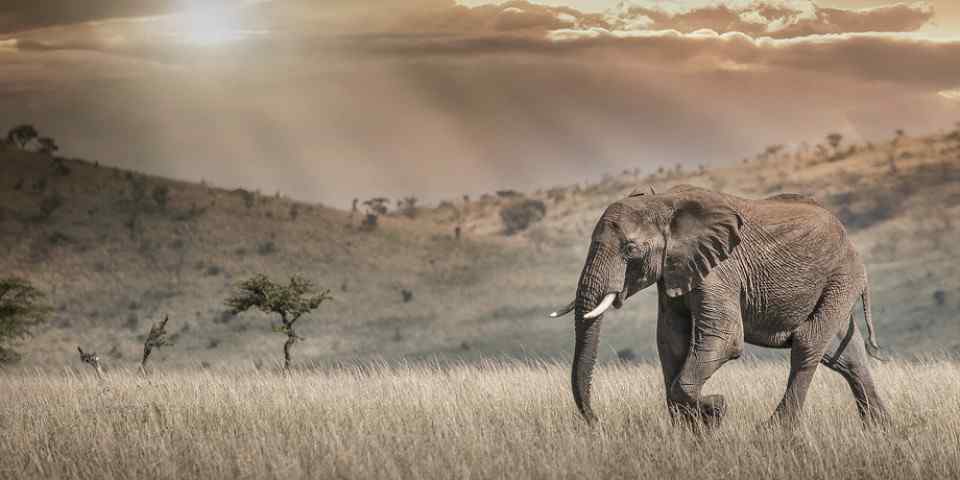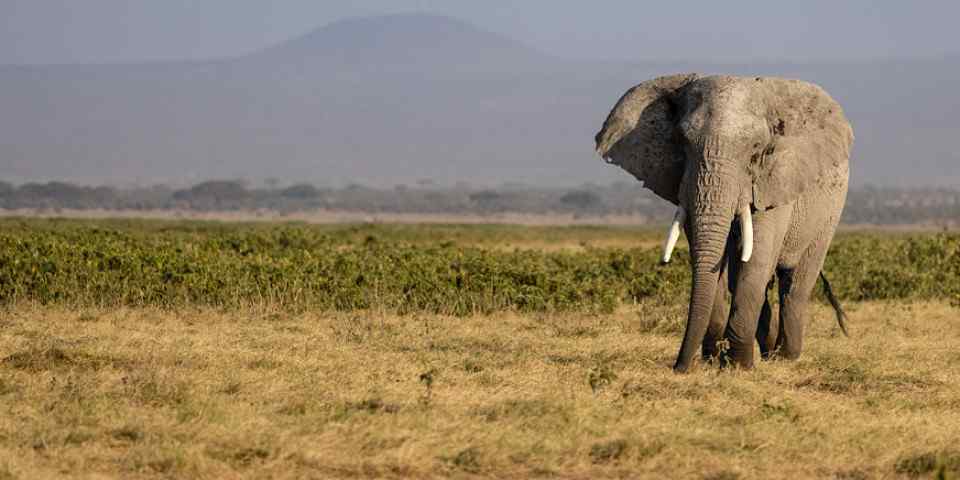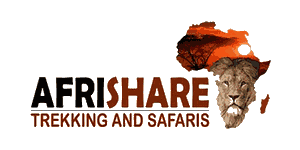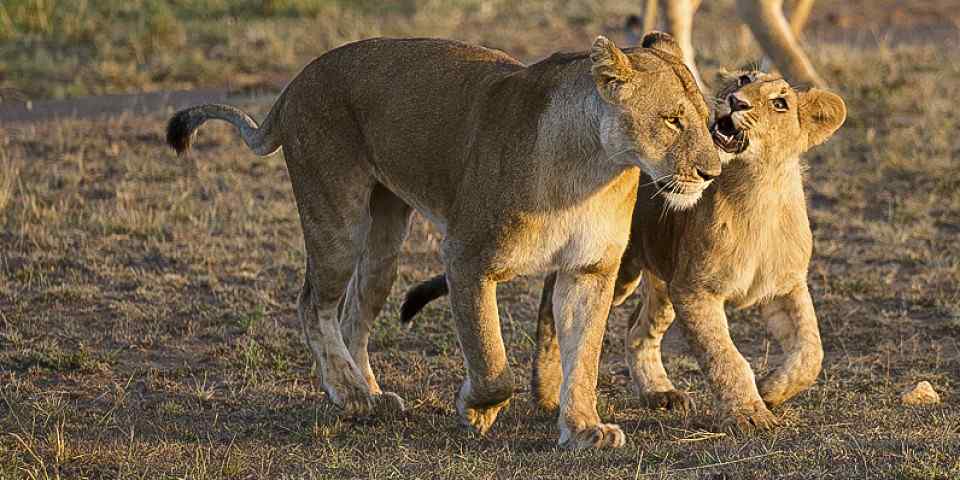Tour Length
Rates in USD $ – Change Currency
Per person, excl. international flightsOperator Rating
Other Tour Features
Filter by Operator
Filter by Accommodation
Masai Mara Safari - Compare 1,467 Tours
If Africa had a Top Five for safari parks, the Masai Mara safari would easily make the final cut. It’s a classic safari destination and one of the best places to see lions, leopards and cheetahs, as well as being home to iconic savannah country that long ago came to define the East African safari. It also has the Big Five (lion, leopard, elephant, buffalo and rhino), a good mix of public areas and private conservancies, and extraordinarily rich accommodations offerings.
-

4-Day Masai Mara-Lake Nakuru Budget Kenya Safari Tour
$596 to $738 pp (USD)
Kenya: Shared tour (max 7 people per vehicle)BudgetTented Camp & Hotel
You Visit: Nairobi (Start), Masai Mara NR, Lake Nakuru NP, Nairobi (End)

Bienvenido Kenya Tours and Safaris
4.7/5 – 146 Reviews
-
Top Rated Operator

9-Day Luxury Big Kenya Safari
$3,710 to $4,600 pp (USD)
Kenya: Private tourLuxuryLodge & Tented Camp
You Visit: Nairobi (Start), Masai Mara NR, Lake Nakuru NP, Lake Naivasha (Naivasha), Amboseli NP, Tsavo West NP, Nairobi (End)

Spirit of Kenya
5.0/5 – 619 Reviews
-
Top Rated Operator

5-Day Luxury Lake Naivasha, Lake Nakuru & Masai Mara
$4,299 to $4,499 pp (USD)
Kenya: Private tourLuxuryLodge & Tented Camp
You Visit: Nairobi (Start), Lake Nakuru NP, Lake Naivasha (Naivasha), Masai Mara NR, Nairobi (End)

Wayfairer Travel

5.0/5 – 196 Reviews
-

6-Day Classic Mara- Nakuru - Amboseli 4 X4 Jeep Safari
$851 to $1,042 pp (USD)
Kenya: Shared tour (max 8 people per vehicle)BudgetTented Camp & Hotel
You Visit: Nairobi (Start), Masai Mara NR, Lake Nakuru NP, Amboseli NP, Nairobi (End)

Alphadean Tours And Safaris
4.8/5 – 27 Reviews
-
Best Seller
![10-Day From Kenya to Tanzania - Mid-Range]()
10-Day From Kenya to Tanzania - Mid-Range
$5,170 to $6,370 pp (USD)
Kenya & Tanzania: Private tour
Mid-range Lodge & Tented CampYou Visit: Nairobi (Start), Lake Nakuru NP, Masai Mara NR, Serengeti NP, Ngorongoro Crater, Lake Manyara NP, Arusha (End)

Soul of Tanzania
4.9/5 – 524 Reviews
-
![3-Day Maasai Mara at a Luxury Camp with a Private Jeep]()
3-Day Maasai Mara at a Luxury Camp with a Private Jeep
$1,005 to $1,559 pp (USD)
Kenya: Private tourLuxuryTented Camp
You Visit: Nairobi (Start), Masai Mara NR, Nairobi (End)

Leisure Escapes Safaris
5.0/5 – 61 Reviews
-
![6-Day Magical Samburu, Nakuru, Mara]()
6-Day Magical Samburu, Nakuru, Mara
$1,792 to $2,296 pp (USD)
Kenya: Private tour
Mid-range Lodge & Tented CampYou Visit: Nairobi (Start), Samburu NR, Lake Nakuru NP, Masai Mara NR, Nairobi Airport (End)

Mara Triangle Safaris
5.0/5 – 34 Reviews
-
![3-Day Masai Mara Fly in Safari Tour]()
3-Day Masai Mara Fly in Safari Tour
$2,184 to $2,576 pp (USD)
Kenya: Private tourLuxuryTented Camp
You Visit: Nairobi (Start), Masai Mara NR, Nairobi (End)

Okoa Africa Tours
4.2/5 – 83 Reviews
-
![4-Day Maasai Mara Safari - Mid Range Camp at Talek Gate]()
4-Day Maasai Mara Safari - Mid Range Camp at Talek Gate
$1,512 to $1,960 pp (USD)
Kenya: Private tour
Mid-range Tented CampYou Visit: Nairobi (Start), Maasai Village (Cultural Village), Masai Mara NR, Nairobi (End)

Samson’s Safaris
4.8/5 – 35 Reviews
-
![8-Day Big Game Magical Kenya African Safari]()
8-Day Big Game Magical Kenya African Safari
$4,148 to $4,801 pp (USD)
Kenya: Private tourLuxuryLodge & Tented Camp
You Visit: Nairobi (Start), Amboseli NP, Lake Naivasha (Naivasha), Lake Nakuru NP, Masai Mara NR, Nairobi (End)

Estleon Adventures
5.0/5 – 153 Reviews
-
Top Rated Operator
![7-Day Masai Mara~Nakuru~Naivasha~Amboseli]()
7-Day Masai Mara~Nakuru~Naivasha~Amboseli
$1,053 to $1,232 pp (USD)
Kenya: Shared tour (max 7 people per vehicle)BudgetTented Camp & Hotel
You Visit: Nairobi (Start), Masai Mara NR, Nakuru (City), Lake Naivasha (Naivasha), Amboseli NP, Nairobi Airport (End)

Jocky Tours and Safaris
4.9/5 – 2,689 Reviews
-
Top Rated Operator
![4-Day Mara & Nakuru Group Sharing]()
4-Day Mara & Nakuru Group Sharing
$650 to $806 pp (USD)
Kenya: Shared tour (max 8 people per vehicle)BudgetTented Camp & Hotel
You Visit: Nairobi (Start), Masai Mara NR, Lake Nakuru NP, Nairobi (End)

Axis Africa Expedition & Safaris
5.0/5 – 2,338 Reviews
-
![3-Day Masai Mara Thrilling Budget Safari]()
3-Day Masai Mara Thrilling Budget Safari
$426 to $650 pp (USD)
Kenya: Shared tour (max 6 people per vehicle)BudgetTented Camp
You Visit: Nairobi (Start), Masai Mara NR, Nairobi (End)

Buffalo Steps Adventures
5.0/5 – 18 Reviews
-
![3-Day Masai Mara Group Joining Jeep Safari]()
3-Day Masai Mara Group Joining Jeep Safari
$594 to $612 pp (USD)
Botswana & Kenya: Shared tour (max 8 people per vehicle)BudgetTented Camp
You Visit: Nairobi (Start), Masai Mara NR, Nairobi (End)

Mountain Hiking Ventures
4.9/5 – 18 Reviews
-
![3-Day Wildebeest Migration Masai Mara Budget Tour]()
3-Day Wildebeest Migration Masai Mara Budget Tour
$750 pp (USD)
Kenya: Shared tour (max 8 people per vehicle)
Mid-range Tented CampYou Visit: Nairobi (Start), Masai Mara NR, Nairobi (End)

Jupicon Expeditions
5.0/5 – 11 Reviews
-
![7-Day Samburu, Nakuru, Mara Cultural Tour with Jeep]()
7-Day Samburu, Nakuru, Mara Cultural Tour with Jeep
$2,195 to $3,130 pp (USD)
Kenya: Private tour
Mid-range Lodge & Tented CampYou Visit: Nairobi (Start), Samburu NR, Ol Pejeta Conservancy (Laikipia Plateau), Lake Nakuru NP, Masai Mara NR, Nairobi (End)

Phine Safaris
4.9/5 – 44 Reviews
-
![6-Day Big Five Tour Masai Mara, Lake Nakuru, Amboseli]()
6-Day Big Five Tour Masai Mara, Lake Nakuru, Amboseli
$1,942 to $1,962 pp (USD)
Kenya: Shared tour (max 7 people per vehicle)
Mid-range LodgeYou Visit: Nairobi (Start), Masai Mara NR, Lake Nakuru NP, Amboseli NP, Nairobi (End)

Simian Safaris
4.8/5 – 34 Reviews
-
![5-Day Kenya and Tanzania Unforgettable Combined Safari]()
5-Day Kenya and Tanzania Unforgettable Combined Safari
$1,925 pp (USD)
Kenya & Tanzania: Private tour
Mid-range Lodge & Tented CampYou Visit: Nairobi (Start), Masai Mara NR, Serengeti NP, Central Serengeti NP, Ngorongoro Crater, Arusha (End)

Afrishare Trekking & Safaris
5.0/5 – 242 Reviews
-
![6-Day Best of Kenya Budget Group Joining Safari]()
6-Day Best of Kenya Budget Group Joining Safari
$875 to $1,075 pp (USD)
Kenya: Shared tour (max 7 people per vehicle)BudgetTented Camp & Hotel
You Visit: Nairobi (Start), Masai Mara NR, Lake Nakuru NP, Amboseli NP, Nairobi (End)

Big Time Safaris
4.2/5 – 200 Reviews
-
Best Seller
![5-Day Lion King and Big 5 Hakuna Matata Kenya Safari]()
5-Day Lion King and Big 5 Hakuna Matata Kenya Safari
$1,467 to $2,167 pp (USD)
Kenya: Private tour
Mid-range Lodge & Tented CampYou Visit: Nairobi (Start), Masai Mara NR, Lake Nakuru NP, Lake Naivasha (Naivasha), Nairobi (End)

Camptrek Safaris
4.9/5 – 153 Reviews
8 Questions About Masai Mara Safaris

Answered by
Anthony Ham
Anthony is a renowned Africa expert and author of many Lonely Planet guidebooks, including the guide to Kenya.› More about Anthony
8 Questions About Masai Mara Safaris
 Anthony Ham
Anthony Ham
When is the best time to see the great migration?
“A word of warning: no one knows the exact moment when the herds of wildebeest and zebra, more than 2 million strong, will cross the border from Tanzania’s Serengeti National Park into Kenya and the Masai Mara. And nor can anyone predict with certainty the precise weeks when the wildebeest will funnel down the banks of and across the crocodile-infested Mara River. But there are some reasonably reliable parameters to help when choosing the time to visit in order to maximize your chances of witnessing one of the greatest wildlife spectacles on the planet. In most years, the herds arrive in the Mara around late July or into August. This is when the massed crossings of the Mara River usually occur. In September and October, the herds usually remain in the Mara, a moving mass of wildlife that is quite extraordinary to see. By late October and almost certainly by November the herds leave Kenya and return to Tanzania.”
› More about the best time to visit the Masai Mara 1What opportunities are there to meet local Maasai people?
“The Maasai are indeed the most soulful human presence in Masai Mara safaris and meeting them and getting to know something about their lives is a highlight of any visit here. Many lodges and safari companies employ Maasai as guides and drivers, and also as employees in their lodges and tented camps. Most can also arrange visits to local Maasai communities – ask your safari operator if this is possible before booking your Kenya safari. It can be difficult to interact meaningfully with the Maasai on such occasions, although you can learn a great deal if you take the time to talk with those guiding you, serving your food or cleaning your rooms. If you want to organize something yourself, there are a number of simple accommodations and Maasai homestay places just outside the Masai Mara’s Sekenani Gate, where you can spend time with a local family and gain an unfettered insight into their lives.”
2How can I avoid the crowds on a Masai Mara safari?
“The easiest way to avoid the crowds is to plan your Masai Mara safari to avoid the period when the migration is in full swing. If that’s not an option, it is almost impossible to shake off the convoys of safari vehicles that surround the Mara River crossings – you might just have to grin and bear it if that’s why you’re here. That said, while all of those vehicles line up along the riverbank, much of the rest of the reserve can be surprisingly quiet. Another option is to stay outside the reserve on one of the private or community conservancies that surround the Masai Mara National Reserve to the north and east. Some of these – Mara North, Naboisho, Olare Orok and Olderikesi in particular – have some of Africa’s highest population densities for big cats and, though expensive, are only accessible for those staying in the conservancies’ small lodges or tented camps. And if you’re staying in one of the conservancies, you can always enter the reserve to see the migration, and then return to the relative quiet of the conservancy when you’ve had enough.”
3What animals can I expect to see on safari in the Masai Mara?
“Big cats are the highlights of Masai Mara tours – there’s a reason the BBC filmed ‘Big Cat Diary’ here. Sightings are by no means guaranteed, but healthy populations of lions mean you’d be very unlucky not to see a pride or two. Further, the long sightlines of the endless grasslands are ideal for spotting cheetah, while the tree-lined rivers that snake through the reserve are perfect leopard habitat. There’s also elephant, buffalo, giraffe, wildebeest, hippo, crocodile, jackal, all manner of gazelle, spotted hyena … Rhino is elusive, but is nonetheless often seen in the Mara Triangle in the early morning or late afternoon. It all adds up to something of a safari smorgasbord, with the very real possibility that you could, on a good day, see the Big Five on a safari drive before breakfast. It’s why you’d need a very good reason not to pencil in the Masai Mara on your itinerary when planning your Kenya tour.”
› More about the Wildlife of the Masai Mara 4How long is the drive to the park?
“Some safari companies, lodges and tented camps will try to tell you that you can drive from Nairobi to the Masai Mara in just three hours, but I’ve never managed it in much less than five. The last stretch of road from Narok to the gates of the Masai Mara is unpaved and despite constant promises that things will improve, access remains slow. Remember also that your lodge may lie deep within the reserve, adding extra driving time to the journey. It is also possible to drive via Nakuru, visiting Lake Nakuru National Park on the way, but the journey will generally take longer to get to the reserve proper, although it is a shorter journey if you’re traveling to the Mara North Conservancy. It is, of course, possible to fly into one of the Masai Mara’s airstrips from Nairobi’s Wilson Airport and avoid the road journey altogether.”
5What condition are the roads in within the Masai Mara?
“Considering the traffic of 4WD vehicles and safari minivans that crisscross the Masai Mara every year, the Mara’s safari tracks are usually in remarkably good condition. A 4WD is preferable, but if you stick to the tracks, which you really should, then you can easily get around without too much trouble except after rains. The short rains usually occur in November and December and rarely cause more than a few puddles that are easy to avoid. Rainfall and muddy roads are more of an issue in March, April and, to a lesser extent, May. All of that said, I visited once in April and enjoyed fine weather, quiet trails and excellent track surfaces. It all depends on the year.”
6What are the best vehicles to have on a Masai Mara safari?
“A 4WD vehicle is always best, and it should usually be one with a reasonably high clearance. It’s even better if it has open sides (which most midrange and top-end lodges and safari operators use) or a pop-up roof. Even so, the workhorse of many a Kenyan safari is the white minivan that has a pop-up roof – you stand on the seats and can see in all directions, which is ideal for taking photos. Most of these minivans are 2WD vehicles and most have little difficulty in negotiating all but the more rugged Masai Mara trails. If you’re the one driving, remember, however, that local drivers are experienced in these conditions and you’ll need to be cautious if driving a 2WD vehicle here, especially in the beginning.”
7What lodges or camps would you recommend?
“There are too many to choose from! When selecting where to stay on Masai Mara tours, remember that the Masai Mara is vast and, if time permits, it may well be worth planning to sleep in a couple of locations in the reserve itself to enable you to enjoy different sectors of the park, plus a couple of the private conservancies. The latter are especially good if you’d like to experience all that Masai Mara safari packages have to offer – stirring scenery, abundant wildlife, Maasai culture – without the crowds. In Mara North, I thought Saruni Mara, Offbeat Mara and Karen Blixen Camp were outstanding, while over in Naboisho Conservancy I loved Asilia Naboisho Camp and Kicheche Valley Camp. And in Olderikesi Conservancy, Cottar’s 1920s Camp is a Mara classic.”
8Masai Mara Safari Reviews

Stuart is a travel writer and author of numerous Lonely Planet guidebooks, including 'Kenya', 'Rwanda' and 'Tanzania'.
East Africa at Its Best
Nowhere else sums up the East African dream like the Masai Mara. Always the best place in Kenya to see huge herds of grazers and a seemingly endless procession of carnivores big and small, the Masai Mara is the one place in East Africa I...

Philip is an acclaimed travel writer and author of many guidebooks, including the Bradt guides to Uganda, Tanzania, Kenya and South Africa.
‘Big Cat Diary’ Made Flesh
The Masai Mara is where the BBC’s ‘Big Cat Diary’ was filmed, and unsurprisingly it ranks as one of the finest reserves anywhere in Africa for big cat sightings. Above all, I associate it with lions: I’ve often encountered four or...
 IT
IT
Best park we visited without doubt. We encountered a lot of wildlife, all with incredible photo perspectives. The off-road allowed us to find some animals in really natural attitude (a cheetah eating a zebra just the first day) and the park...
Fantastic contrast against the Serengeti and allowed us to gain a greater perspective of the migration route. We captured some amazing moments here with wildlife and would visit again without hesitation.
 CN
CN
Too many unbelievable sceneries, still wanting more
The wonderful 6days 5nights. Moses took us to the best positions to look at the animals quickly. Cheetah hunting, elephants eating, giraffes walking. All of these shows the freedom of this magical land, Africa. I was sitting in the...
 PT
PT
3 Days wildlife safari
Kenya is a breathtaking destination filled with stunning landscapes, abundant wildlife, and warm, welcoming people. From the Maasai Mara to the vibrant streets of Nairobi, every moment was unforgettable. Truly a dream come true for nature...































